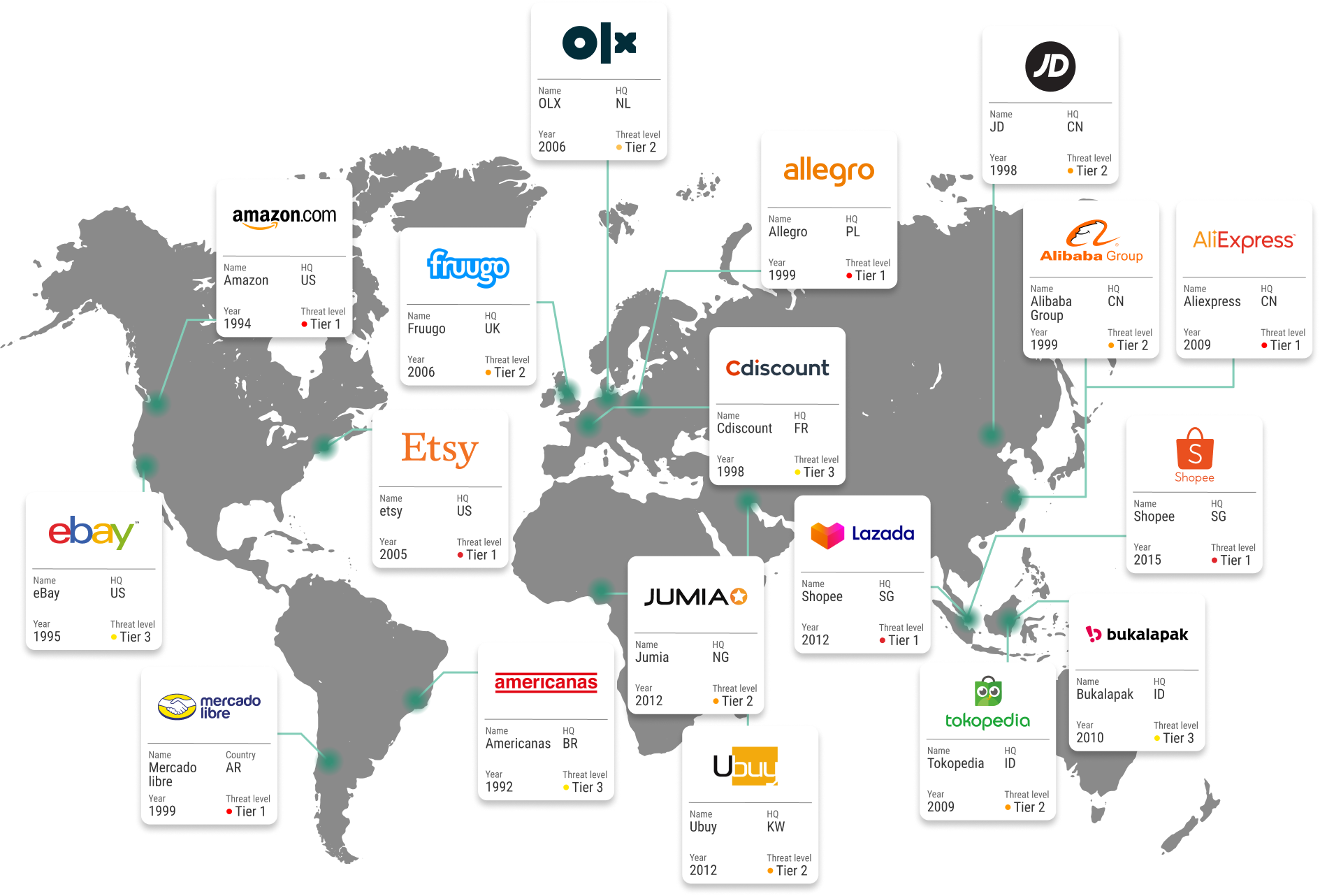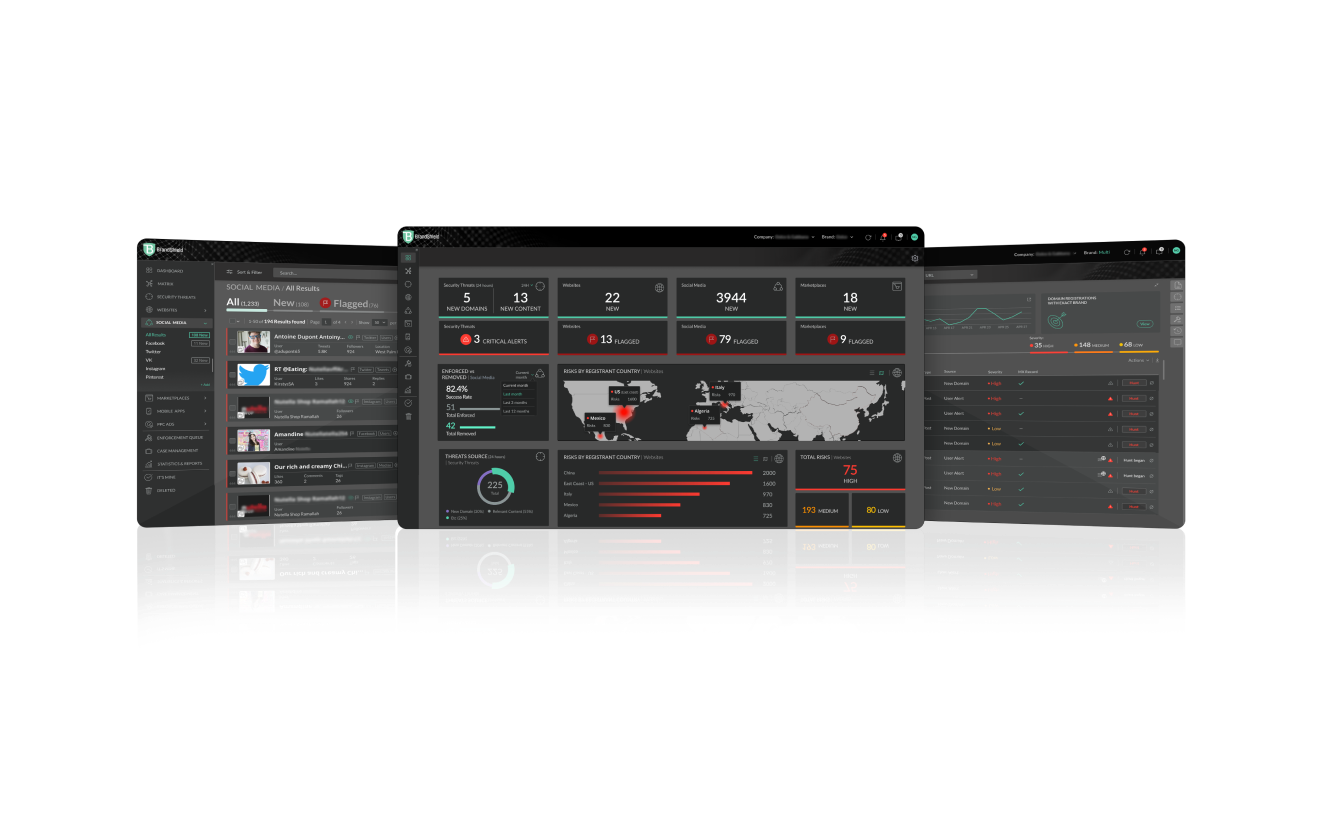Online marketplaces have changed e-commerce forever and given smaller brands a chance to grow, but these sites pose numerous challenges around online brand protection. Here’s what you need to know to safeguard your brand’s reputation and bottom line.
Marketplace brand protection challenges
Counterfeit sales
The unauthorized sale of products designed to look similar to another product and brand, in an attempt to make a profit. Brands leak revenues and their good names on their account.
Gray market
Genuine products that are sold outside of the authorized distributor. Gray market damages not only a brand’s direct income and reputation but its distribution channel as well.
Trademark infringement
Scammers exploit brand names, phrases, and logos trademarked by a company for the purpose of misleading innocent people to visit their website or buy fake products from them.
Fake marketplaces
Innocent buyer pays for a completely fake listing. They then receive an entirely different product than what was advertised, or alternatively, they do not receive any product at all.
Copyright infringement
Copyright infringement occurs when fake sellers display genuine product images or enable the download of a copyrighted image, sound or
movie files.
Shadow products
Products advertised on marketplaces as being in the spirit of a specific well-known brand, sometimes using similar colors, fonts, or designs to evoke the brand.
Online marketplace damage: what you need to know
A huge percentage of world trade today happens through online marketplaces. This shift to e-commerce has seen traditional geographical boundaries for merchants and brands nearly disappear, as users all over the world can now purchase items, without the need for a physical storefront in their vicinity.
One significant difference of online marketplaces is that they are already set up platforms, which can sell products to all consumers. While it is not difficult to start an online shop and sell counterfeit products, A lot of development goes into the process, from SEO work, to advertising. With online marketplaces a lot of the process is already structured and requires no effort on the part of those trying to sell counterfeits.
Revenue loss
The proliferation of online marketplaces has proved both a blessing and a curse. As millions of customers are already shopping on these platforms, brands can be found more easily and have an alternative channel to distribute their produce. don’t need to pour time and money into driving traffic to their websites. On the other hand, these marketplaces are often very crowded and competition between brands is fierce. Counterfeit and fake products purporting to be a particular brand are all too common.
Damage to Brand Reputation
This can prove challenging for all brands. Online marketplaces make it easier than ever for counterfeiters to sell knock-off and inauthentic products, which in turn triggers a hit to both a brand’s revenue and its reputation.
Damage to relationship with distributors
Distributor issues are another serious consideration. Companies sell through their own websites, online marketplaces, partners and distributors, brands have to monitor a complicated series of moving parts regarding their pricing. Damaging the distributor relationship can have various consequences from canceled distribution agreements, demands to lower their cost with you, being sued, or just general complaints. This will give the business more work in maintaining these relationships, to keep the distributor happy.
Critical differences between online marketplaces
No matter where your company is based or where you operate, you are obligated to follow local laws. And those laws can vary widely when it comes to issues around privacy, counterfeiting, and the gray market. This makes marketplace brand protection something that needs to be constantly tweaked and adjusted depending on the region.
Specific countries that have different laws about counterfeits and gray markets. China, Russia, Vietnam, Indonesia and Malaysia do share some common policies, albeit with a few significant procedural differences, which are vastly different to American IP laws. These marketplaces generally make it challenging for brands to secure the removal of counterfeits, and are not typically focused on online brand protection.
Different Local requirements:
There are a number of differences in brand protection requirements between countries, specifically in the online marketplaces located in Asia. Legislation differs between countries, requiring brands a range of expertise in order to handle taking down counterfeits in these areas.
The fact that Chinese marketplaces are extremely popular, with millions of listings, sellers, and purchasers, makes fake products and brand impersonators somewhat tougher to spot. A stunning 28% of the world’s manufacturing is based in China, which means that it’s extremely easy to create and obtain branded products – whether genuine or counterfeit.
Many businesses are aware of the issues facing their brands on particular platforms, and may want to focus on those areas as a first priority. This patchwork strategy can provide temporary relief, however companies need to embrace an A-Z big picture focus, applying to multiple sites, as an all encompassing marketplace brand protection solution. While it is highly difficult to monitor the thousands of online marketplaces simultaneously, prioritizing the most critical ones is the ongoing best practice.
Compared to other sites, Amazon is a relatively brand-protection oriented marketplace. The ecommerce titan has their own tools which are meant to help brands protect themselves from counterfeits, trademark, and copyright infringement. Overall, marketplaces have different compliance regulations and takedown protection procedures, so brands must be familiar with each one individually.
Here is a map with leading marketplaces, their origin, number of localizations, and threat level:

BrandShield’s unique marketplace brand protection
These features, among others, help reduce the risk of fake listings slipping through the cracks so you can be confident your business is protected.
Since individual marketplaces use different technologies, BrandShield tailors its solution for each customer and continuously monitors marketplaces to ensure faster responses to emerging threats.
BrandShield’s enforcement managers and threat hunters are experienced IP professionals with extensive hands-on legal expertise. They regularly perform takedowns across all online marketplaces, achieving a remarkable 98% success rate. Leveraging the deep experience of our team, we specialize in resolving complex, challenging cases. Beyond removing counterfeits, we also address difficult gray market issues by applying our industry expertise and broad knowledge.
Automation is a critical factor in resolving online marketplace brand threats quickly and effectively. BrandShield leverages proprietary technology, including dedicated crawlers and APIs, to automatically monitor hundreds of marketplaces. All data gathered is retrieved and analyzed using our internal tools. These tools automate the detection of violations, unlike other brand protection services that rely on time-consuming manual analysis. Effective marketplace protection requires this level of intelligent automation.
BrandShield provides your business with a holistic, big-picture view of the threats facing your brand across online marketplaces. Our solution is designed to safeguard your enterprise from a wide range of digital risks, combining advanced proprietary tools with a team of industry experts. To learn more about how BrandShield’s marketplace protection technology can help your company combat counterfeits, get in touch with us today.
Clear ROI
Clear model to demonstrate ROI including reports.
Robust AI/ML based features
Image search, Optical Character Recognition
(OCR), Repeat offender detection, and more.

Cluster capabilities
Detect and remove hundreds of listings at once.
Takedown by IP experts
All remediation managed by experienced enforcement managers with IP background.
Advanced crawling and scraping
Hundreds of dedicated marketplace crawlers to enable mass detection and takedowns.
The Amazon conundrum: how is the most popular marketplace ever protecting itself from scams?
Being the biggest eCommerce in the world, Amazon is now the #1 target for fraudsters. Amazon quickly understood what risks it took without efficient brand protection. To protect itself and its customers from severe financial loss and reputation damages, Amazon put in place different levels of brand protection to maximize the efficiency of their protection program.
Learn from the biggest marketplace and read more about their protection tactics.